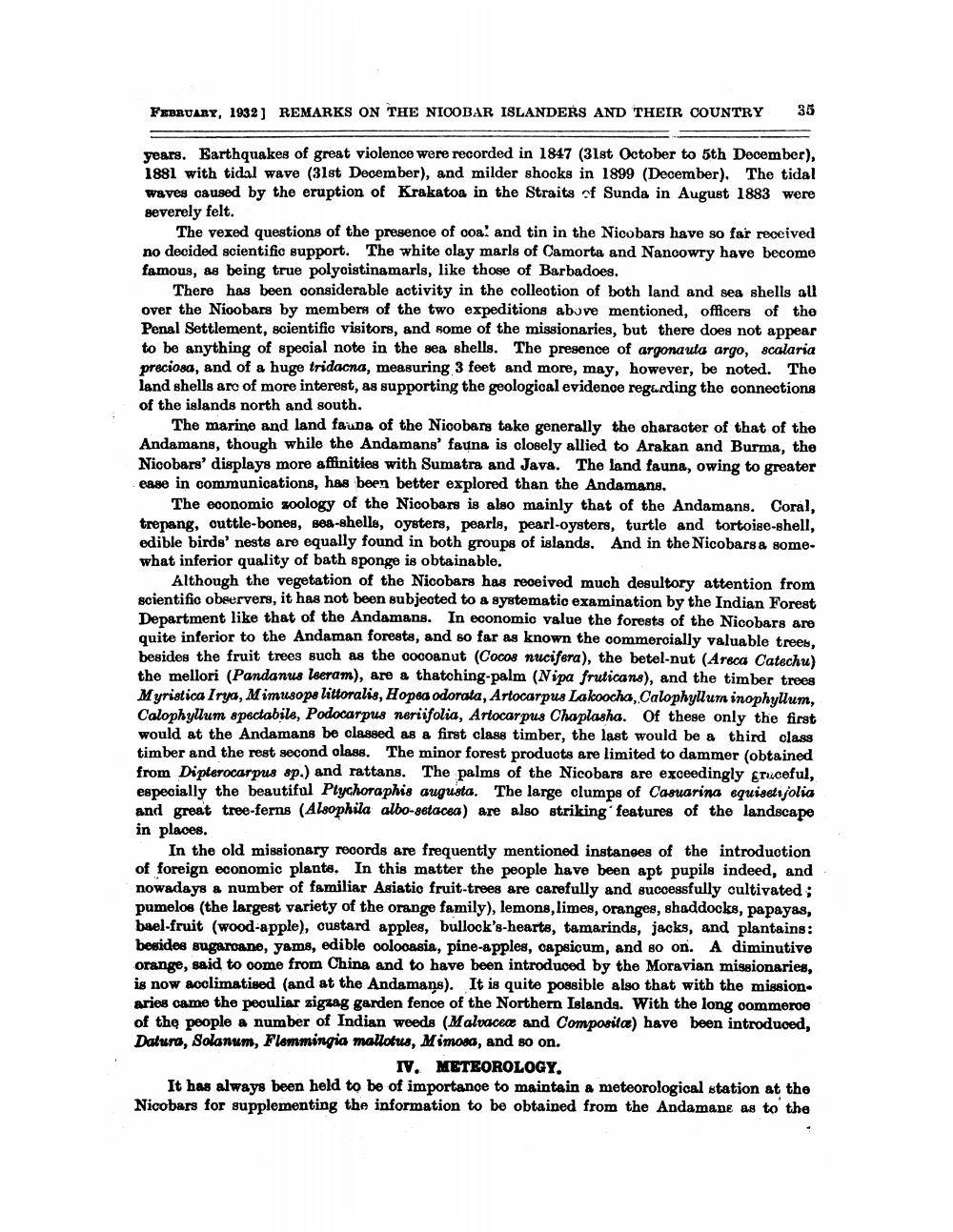________________
FEBRUARY, 1932) REMARKS ON THE NICOBAR ISLANDERS AND THEIR COUNTRY
35
years. Earthquakes of great violence were recorded in 1847 (31st October to 5th December), 1881 with tidal wave (31st December), and milder shocks in 1899 (December). The tidal waves caused by the eruption of Krakatoa in the Straits of Sunda in August 1883 were severely felt.
The vexed questions of the presence of ooa' and tin in the Nicobars have so far received no decided scientific support. The white clay marls of Camorta and Nanoowry have become famous, as being true polyoistinamarls, like those of Barbadoes.
There has been considerable activity in the colleotion of both land and sea shells all over the Nioobars by members of the two expeditions above mentioned, officers of the Penal Settlement, scientific visitors, and some of the missionaries, but there does not appear to be anything of special note in the sea shells. The presence of argonauta argo, scalaria preciosa, and of a huge tridacna, measuring 3 feet and more, may, however, be noted. The land shells are of more interest, as supporting the geological evidence regarding the connections of the islands north and south.
The marine and land fauna of the Nicobang take generally the character of that of the Andamang, though while the Andamans' fauna is closely allied to Arakan and Burma, the Nicobars' displays more affinities with Sumatra and Java. The land fauna, owing to greater ease in communications, has been better explored than the Andamans.
The economic zoology of the Nicobars is also mainly that of the Andamans. Coral, trepang, outtle-bones, sea-shells, oysters, pearls, pearl-oysters, turtle and tortoise-shell, edible birds' nests are equally found in both groups of islands. And in the Nicobars & somewhat inferior quality of bath sponge is obtainable.
Although the vegetation of the Nicobars has received much desultory attention from scientific obeervers, it has not been subjected to a systematic examination by the Indian Forest Department like that of the Andamans. In economic value the forests of the Nicobars are quite inferior to the Andaman forests, and so far as known the commercially valuable trees, besides the fruit trees such as the cocoanut (Cocos nucifera), the betel-nut (Areca Catechu) the mellori (Pandanus leeram), are & thatching-palm (Nipa fruticans), and the timber trees Myristica Irya, Mimusope littoralis, Hopea odorata, Artocarpus Lakoocha, Calophyllum inophyllum, Calophyllum spectabile, Podocarpus neriifolia, Artocarpus Chaplasha. Of these only the first would at the Andamans be classed as a first class timber, the last would be a third class timber and the rest second olass. The minor forest products are limited to dammer (obtained from Dipterocarpus sp.) and rattans. The palms of the Nicobars are exceedingly Eruceful, especially the beautiful Ptychoraphis augusta. The large clumps of Casuarina equisetifolia and great tree-ferns (Alsophila albo-setacea) are also striking' features of the landscape in places.
In the old missionary records are frequently mentioned instances of the introduction of foreign economic plants. In this matter the people have been apt pupils indeed, and nowadays a number of familiar Asiatic fruit-trees are carefully and successfully cultivated; pumelos (the largest variety of the orange family), lemons, limes, oranges, shaddocks, papayas, bael-fruit (wood-apple), custard apples, bullock's-hearte, tamarinds, jacks, and plantains: besides bugarcane, yams, edible oolooasia, pine-apples, capsicum, and so on. A diminutive orange, said to come from China and to have been introduced by the Moravian missionaries, is now acclimatised (and at the Andamans). It is quite possible also that with the missionaries came the peculiar zigzag garden fence of the Northern Islands. With the long commerce of the people a number of Indian weeds (Malvacece and Composita) have been introduced, Datura, Solanum, Flemmingia mallotus, Mimosa, and so on.
IV. METEOROLOGY, It has always been held to be of importance to maintain a meteorological station at the Nicobars for supplementing the information to be obtained from the Andamane as to the




